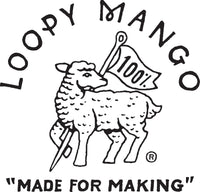Pattern Levels
All project levels are offered merely as guidelines; we want to empower you to achieve your knitting goals by helping you learn new skills and processes through fun, achievable projects you’ll be proud to wear! Each pattern level builds on the one(s) before it.
We have a wide assortment of video tutorials to walk you through certain stitches and processes. If you have any questions, feel free to email us at loopy@loopymango.com. Levels below are for our KNITTING patterns. For CROCHET levels refer to this page.
If you'd like to shop our DIY Kits by level, we've made collections to help you!
ABSOLUTE BEGINNER • BEGINNER • INTERMEDIATE • ADVENTUROUS INTERMEDIATE • ADVANCED
Absolute Beginner
- No prior knitting experience is necessary.
- Projects only require the Knit stitch, casting on and casting off.
Beginner
Ability to do the following:
- Cast on
- Knit Stitch
- Purl Stitch
- Cast off
Projects will involve the following:
- You will employ both the Knit stitch and Purl stitch.
- You may combine Knit and Purl stitch patterns for ribbing or seed (moss) stitch.
- Simple shaping: increase and decrease stitches
- Some projects may be knit in the round
- Slip stitches
Intermediate
Proficiency in the following:
- Proficiency of Beginner skill set
- Combination Knit and Purl stitch patterns: Seed, Moss, etc.
- Picking up stitches
- Seaming pieces, more involved finishing techniques
- Knitting in the round
- Ability to read knitting patterns and familiarity with standard knitting abbreviations
Projects may also involve:
- Simple cables
Adventurous Intermediate
- Proficiency of Beginner + Intermediate skill sets
- Comfortable reading more involved patterns
- Lace work
- Ability to read knitting patterns and familiarity with standard knitting abbreviations
Advanced
- Proficiency of Intermediate skill sets + Adventurous Intermediate skill sets
- Very comfortable reading patterns and familiarity with standard knitting abbreviations
- Colorwork
- Ability to work on small needles - size US7 (4.5 mm) and smaller
- Proficiency working on DPN's (double pointed needles) or magic loop technique
- Proficiency with more complicated cable patterns


